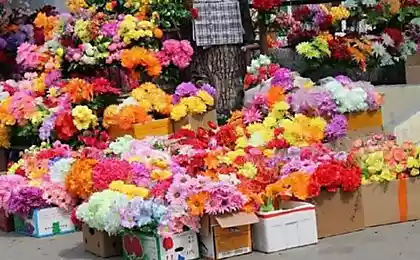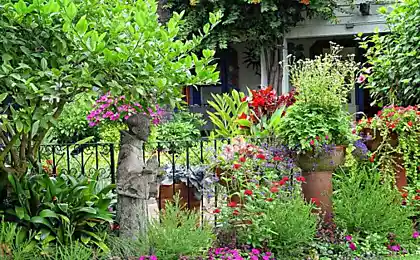428
Cyclamen in Your house: breeding and care
Cyclamen in many countries along with the Decembrist, poinsettias, cacti, and bulbous is a wonderful decoration for the New year.
Location:
Cyclamen prefers bright ambient light, partial shade, well ventilated, but without drafts and away from heat sources.
Soil:
Cyclamen are planted in a mixture of turf and ground sheet with the addition of lime rubble, crushed lime or old plaster. Planting requires good drainage, as plants suffer from a slight saturation.

Watering:
Watering in the flowering period — rich but not waterlogged; in the dormant period — a rare, but without drying earthen coma. Do not pour water on the top of the tuber. In any case be allowed, that water has got into the middle of the rhizome, at the base of petioles, or buds. Watering is better done from below, pouring water in the pan.
Humidity:
As the cyclamen likes moist air, then put the pot on a tray of pebbles or damp peat. Spray the cyclamen, you cannot, you can only humidify the air around the plant with a very fine spray.
Temperature:
During flowering 13-16°C during the rest period is 10-18°C.
Transplant:
When transplanting the old soil is replaced completely. Ground for the Persian cyclamen should consist of 1 part leaf, 1 part humus, 1 part sod land and 1 part sand. When transferring, check the root system, it is necessary to remove all diseased or decayed roots. Pot of cyclamen should not be very big, the best size is 12-14 cm in diameter. In too small a pot cyclamen will bloom prematurely, and flowering will be weak.
For other types of soil it is desirable to add fly ash or dolomite to neutral, with the ground for the Neapolitan and European cyclamen should be nutritious, cos the poor.
When transplanting, do not bury the tubers of the Persian cyclamen, leaving the top about one third of the tuber, the rest can be sunk, and Neapolitan bury necessarily.After the transplant the cyclamen is placed on a bright place with shading from direct sunlight, watering the first two weeks after transplantation should be moderate, until the plant will not grow and will not grow new leaves.

Reproduction:
Propagated by dividing the old tubers during dormancy or from seed (for seed production need artificial pollination).The seeds germinate very difficult. Persian cyclamen seeds sown when ripe in a pot, well covered with earth, as the light they do not germinate.
Pot regularly watered, that the soil was constantly moist. You can close the glass crops. Sprouting undesirable high temperature, the optimum — 15°...18°.
Seedlings appear in about a month. Seeds small wild cyclamen to improve germination sow after dry storage, i.e. 3-6 months just in the package, and then deal with them as well as Persian. Seedlings bloom for 3-4 year when the tuber sufficient to increase.
If you buy a tuber of cyclamen, pay attention to how much it weighs. The tuber needs to be heavy and not wrinkled. See if tuber buds. They are located at the top and a little bit like sprouts begonias. Planting should be done in the period of vegetative rest, at a depth of 5-10 cm for best protection from frost, but in southern areas they can stay polusharovidnye in nature.
You need to treat them carefully without damaging the surface, because the juicy tubers can easily rot. If there are stems, they also undesirable damage to not lose a kidney. Transplant can weaken the tubers, so the longer not to touch them, the better they bloom. In one place can be a very long time.Obrazkami required. Remove dead leaves and spent flowers, being careful not to leave the grounds of the stalks, are prone to decay.
Fertilizing:
During active growth and flowering, fertilize 1 times per two weeks of full mineral fertilizer.
Possible difficulties:
In a cold room with high humidity or poor air circulation on the plants may appear gray mold in the form of fluffy growths on the flowers and buds. The leaves turn yellow, the flowers healthy.
The reason — the temperature above 18°C. Other possible reasons — lack of watering and direct sunlight. The stalks and petioles of the leaves are soft and rot. The reason — waterlogging of the soil, especially when watering from the top. Short flowering period. The reason — the temperature above 18°C dry air. published
P. S. And remember, only by changing their consumption — together we change the world! © Join us at Facebook , Vkontakte, Odnoklassniki
Source: vk.com/public44431169?w=wall-44431169_328706
Location:
Cyclamen prefers bright ambient light, partial shade, well ventilated, but without drafts and away from heat sources.
Soil:
Cyclamen are planted in a mixture of turf and ground sheet with the addition of lime rubble, crushed lime or old plaster. Planting requires good drainage, as plants suffer from a slight saturation.

Watering:
Watering in the flowering period — rich but not waterlogged; in the dormant period — a rare, but without drying earthen coma. Do not pour water on the top of the tuber. In any case be allowed, that water has got into the middle of the rhizome, at the base of petioles, or buds. Watering is better done from below, pouring water in the pan.
Humidity:
As the cyclamen likes moist air, then put the pot on a tray of pebbles or damp peat. Spray the cyclamen, you cannot, you can only humidify the air around the plant with a very fine spray.
Temperature:
During flowering 13-16°C during the rest period is 10-18°C.
Transplant:
When transplanting the old soil is replaced completely. Ground for the Persian cyclamen should consist of 1 part leaf, 1 part humus, 1 part sod land and 1 part sand. When transferring, check the root system, it is necessary to remove all diseased or decayed roots. Pot of cyclamen should not be very big, the best size is 12-14 cm in diameter. In too small a pot cyclamen will bloom prematurely, and flowering will be weak.
For other types of soil it is desirable to add fly ash or dolomite to neutral, with the ground for the Neapolitan and European cyclamen should be nutritious, cos the poor.
When transplanting, do not bury the tubers of the Persian cyclamen, leaving the top about one third of the tuber, the rest can be sunk, and Neapolitan bury necessarily.After the transplant the cyclamen is placed on a bright place with shading from direct sunlight, watering the first two weeks after transplantation should be moderate, until the plant will not grow and will not grow new leaves.

Reproduction:
Propagated by dividing the old tubers during dormancy or from seed (for seed production need artificial pollination).The seeds germinate very difficult. Persian cyclamen seeds sown when ripe in a pot, well covered with earth, as the light they do not germinate.
Pot regularly watered, that the soil was constantly moist. You can close the glass crops. Sprouting undesirable high temperature, the optimum — 15°...18°.
Seedlings appear in about a month. Seeds small wild cyclamen to improve germination sow after dry storage, i.e. 3-6 months just in the package, and then deal with them as well as Persian. Seedlings bloom for 3-4 year when the tuber sufficient to increase.
If you buy a tuber of cyclamen, pay attention to how much it weighs. The tuber needs to be heavy and not wrinkled. See if tuber buds. They are located at the top and a little bit like sprouts begonias. Planting should be done in the period of vegetative rest, at a depth of 5-10 cm for best protection from frost, but in southern areas they can stay polusharovidnye in nature.
You need to treat them carefully without damaging the surface, because the juicy tubers can easily rot. If there are stems, they also undesirable damage to not lose a kidney. Transplant can weaken the tubers, so the longer not to touch them, the better they bloom. In one place can be a very long time.Obrazkami required. Remove dead leaves and spent flowers, being careful not to leave the grounds of the stalks, are prone to decay.
Fertilizing:
During active growth and flowering, fertilize 1 times per two weeks of full mineral fertilizer.
Possible difficulties:
In a cold room with high humidity or poor air circulation on the plants may appear gray mold in the form of fluffy growths on the flowers and buds. The leaves turn yellow, the flowers healthy.
The reason — the temperature above 18°C. Other possible reasons — lack of watering and direct sunlight. The stalks and petioles of the leaves are soft and rot. The reason — waterlogging of the soil, especially when watering from the top. Short flowering period. The reason — the temperature above 18°C dry air. published
P. S. And remember, only by changing their consumption — together we change the world! © Join us at Facebook , Vkontakte, Odnoklassniki
Source: vk.com/public44431169?w=wall-44431169_328706






















